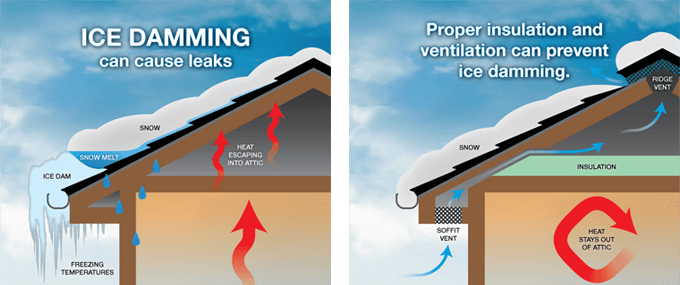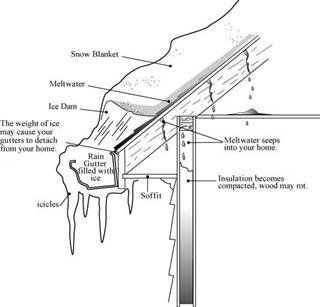Blog Layout
Taking Action Against Ice Damming This Winter

What You Should Know to Help Protect Your Roof
Are ice dams damaging your roof? Above average snowfall and below average cold temperatures throughout the winter season may leave homeowners finding that the wrath of this winter has left long-term roof damage in its wake. During the winter season, homeowners should pay special attention to their roofs and problems caused by wintry weather. Snow, sleet, ice and rain will all test the fortitude of a roof’s construction, materials and their installation. A roof can experience ice dams, icicles, avalanches and even collapse under the impacts of the season, so it is in the best interest of the homeowner to pay special attention.
The colder winter months will primarily test the insulation and ventilation of a home. Proper insulation and ventilation of an attic will keep heat inside of a home, and may help homeowners save money on heating costs. The right combination of insulation and ventilation will also prevent ice dams from forming on the roof.
An ice dam is a layer of ice that forms at the edge of a roof when heat from an attic can cause snow on the roof to melt. The melted snow can then reach the cold overhang at the eave and re-freeze, causing an ice dam. Large, prevalent icicles can be one indicator that an ice dam has formed. The key concern with ice dams is that water from melting snow can back up behind the dam and find its way under shingles, then leak into your home. In regions hit hard during winter, the seemingly harmless icicles dangling from rooftops may actually signal potential ice dams. An ice dam is a wall of ice along the edge of the roof that forms when melting snow continually thaws over warmer portions of the roof and refreezes along the roof’s colder eaves. The melted water that pools behind the ice dam gets trapped, creating the potential to leak into the home and cause damage to walls, ceilings, insulation and other structural areas. To help avoid the increased potential for ice dam damage on your home, consider following these tips:
Proactive: Bring in the Trusted Experts. Call a local expert who can evaluate your roof for damage and determine what your roof needs are. This could include additional shingles, underlayments, ice and water barrier products, ventilation and/or additional insulation.
Preventive: Prepare your home for next year’s winter. Clean gutters and downspouts of debris each fall before winter strikes.
Has your attic been inspected for proper attic ventilation and insulation.
Speak with a Professional
(732) 566-0944


